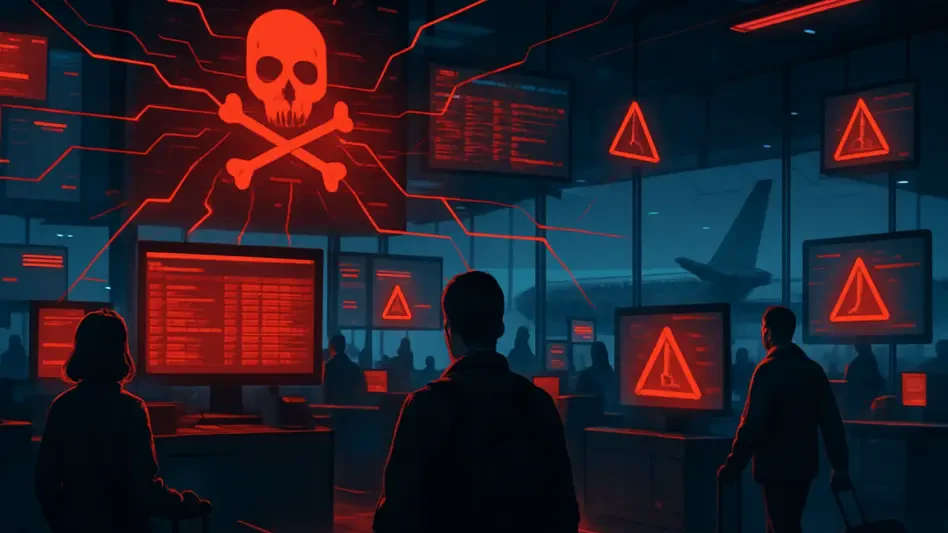Imagine boarding a flight at one of Europe’s busiest hubs, only to find check-in systems down, baggage handling stalled, and thousands of passengers stranded due to a mysterious digital attack. This scenario unfolded recently across major airports like Heathrow, Brussels, Berlin, and Dublin, where a suspected cyber-attack on RTX’s Muse software—a critical tool for check-in and baggage processes—disrupted operations for three consecutive days. The aviation industry, heavily reliant on interconnected digital systems, faced a harsh reality check as flights were delayed or canceled by the thousands. This roundup gathers diverse perspectives from cybersecurity professionals, industry leaders, and airport responses to explore the vulnerabilities exposed by this incident and compile actionable strategies for resilience in the face of growing cyber threats.
Unpacking the Crisis: What Happened and Why It Matters
The scale of disruption at European airports has spotlighted a glaring weakness in aviation’s digital infrastructure. A breach targeting RTX’s Muse software, used by numerous airlines for essential operations, triggered a domino effect, halting automated processes and forcing staff to resort to manual, pen-and-paper methods. Reports indicate that the ripple effects impacted not just one airport but an entire network of hubs, amplifying the chaos as passengers faced uncertainty and long delays.
Beyond the immediate inconvenience, this incident raises critical questions about the industry’s dependence on third-party systems. The interconnected nature of these platforms means that a single point of failure can paralyze multiple stakeholders simultaneously. As airports and airlines scrambled to manage the fallout, the event underscored a broader concern: how can such a vital sector safeguard itself against increasingly sophisticated cyber threats?
This compilation of insights aims to dissect the root causes of this disruption while presenting a spectrum of expert opinions on mitigating similar risks. From technical defenses to operational contingencies, the perspectives gathered here offer a comprehensive look at what went wrong and how the industry might fortify itself moving forward.
Diverse Perspectives: Expert Opinions on Aviation Cybersecurity
Supply Chain Vulnerabilities: A Systemic Flaw
One recurring theme among cybersecurity specialists is the danger posed by supply chain attacks, as seen in the targeting of RTX’s software. Many professionals point out that third-party providers often represent a blind spot in security protocols, as their systems are integral yet not always directly controlled by airlines or airports. A breach in one vendor’s platform can cascade through an entire ecosystem, bringing operations to a standstill across borders.
Some experts argue that the aviation sector’s push for efficiency through shared digital tools has inadvertently created a fragile network. While streamlined systems reduce costs and improve coordination, they also concentrate risk in fewer points of vulnerability. This perspective calls for a reevaluation of how much reliance is placed on external suppliers without corresponding oversight or redundant safeguards.
A contrasting view suggests that while supply chain risks are real, they can be managed through rigorous vetting and mandatory security standards for vendors. Advocates of this approach emphasize joint accountability, where airlines and airports work closely with providers to ensure robust defenses are in place. This collaborative model could reduce the likelihood of widespread disruptions stemming from a single weak link.
Human Readiness: The Role of Manual Contingencies
Another angle focuses on the human element in cybersecurity, with several industry voices advocating for enhanced staff training to handle system failures. The recent airport disruptions revealed a gap in preparedness, as many employees struggled to pivot to manual processes when digital tools became unavailable. Experts in this camp stress the importance of regular drills to ensure personnel can manage check-ins and baggage handling without technology.
This viewpoint also highlights the concept of graceful failure mechanisms—systems designed to degrade in a controlled manner rather than collapse entirely during an attack. By embedding such strategies into operations, airports could maintain a baseline of functionality even under duress. This approach prioritizes resilience over pure prevention, acknowledging that breaches may be inevitable in a hyper-connected world.
A differing opinion cautions against over-relying on manual backups, noting that they are often slower and error-prone, especially in high-volume environments like major airports. Proponents of a balanced strategy suggest integrating semi-automated interim solutions that can bridge the gap during outages. This hybrid model aims to combine the reliability of human oversight with the efficiency of partial automation, offering a practical middle ground.
Proactive Defenses: Technology as a Shield
On the technological front, many cybersecurity leaders push for proactive measures like continuous monitoring and rapid software updates to thwart attacks before they escalate. The breach of RTX’s Muse software serves as a stark reminder that outdated systems or delayed patches can become easy targets for malicious actors. Strengthening these defenses requires constant vigilance and investment in cutting-edge tools to detect anomalies early.
Some specialists also advocate for robust backup systems that can seamlessly take over during an outage, minimizing disruption to passengers and operations. This includes redundant data storage and alternative processing platforms that operate independently of primary systems. Such infrastructure, though costly, is seen as a necessary buffer against the growing complexity of cyber threats.
However, a counterargument warns that technology alone cannot solve the problem, as attackers often adapt faster than defenses can evolve. This perspective urges a diversified approach, combining digital fortifications with policy changes and international cooperation. Sharing threat intelligence across borders, for instance, could enable quicker responses to emerging risks, creating a united front against cyber adversaries.
Airport Responses: Managing the Immediate Fallout
Feedback from affected airports provides a ground-level view of the crisis, showcasing varied strategies to cope with the disruptions. Certain hubs, like Brussels, publicly identified the incident as a cyber-attack and urged passengers to check in online before arriving, aiming to reduce on-site congestion. This transparent communication helped set expectations and mitigate frustration among travelers.
Other airports, such as Heathrow, focused on issuing apologies and advising passengers to arrive only at designated times, preventing overcrowding during delays. This approach prioritized crowd control and safety, though it faced criticism for lacking detailed updates on recovery timelines. The divergence in messaging reflects differing priorities between operational stability and passenger reassurance.
A broader lesson from these responses is the need for standardized communication protocols during cyber incidents. Some industry observers suggest that a unified framework for public announcements could streamline efforts to manage chaos, ensuring consistent information reaches all stakeholders. This idea ties into the larger theme of collaboration, extending beyond technology to encompass crisis management practices.
Key Takeaways: Building a Stronger Aviation Sector
Reflecting on the insights gathered, it becomes clear that the cyber-attack on European airports exposed deep-seated vulnerabilities in supply chain dependencies and digital interconnectedness. Experts largely agree on the necessity of multi-layered defenses, though their approaches vary—from bolstering human readiness with manual training to investing in advanced monitoring technologies. The diversity of opinions underscores a shared urgency to act, even if the paths to resilience differ.
Airport responses during the crisis highlighted both strengths and gaps in current practices, with communication emerging as a critical area for improvement. The incident also reinforced the value of cross-border information sharing, as cyber threats rarely respect geographic boundaries. These lessons provide a roadmap for addressing immediate weaknesses while preparing for future challenges.
Looking ahead, the aviation industry must commit to actionable steps like adopting rigorous vendor security standards and developing contingency plans that balance human and technological resources. Stakeholders, including airlines and passengers, should stay informed by monitoring official updates and supporting collaborative recovery efforts. Further exploration of industry reports and cybersecurity forums can deepen understanding of evolving threats, ensuring that this disruption serves as a catalyst for lasting change rather than a recurring nightmare.








